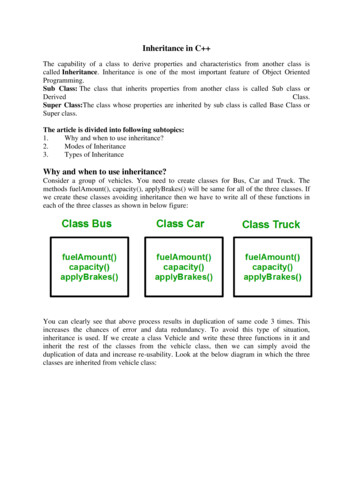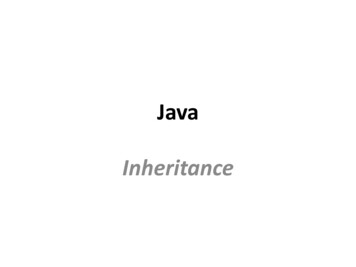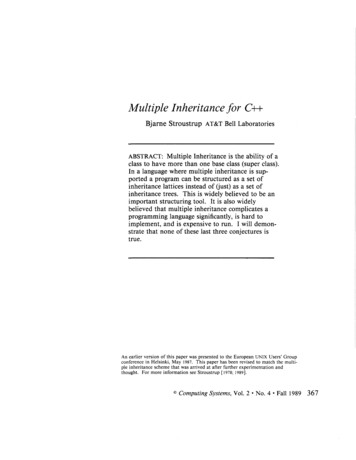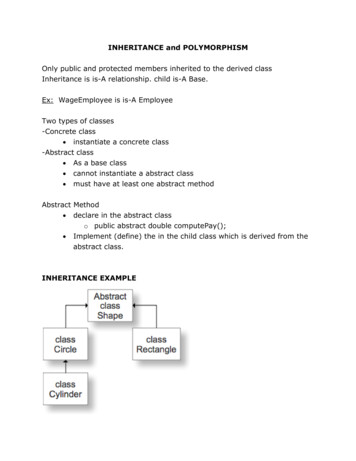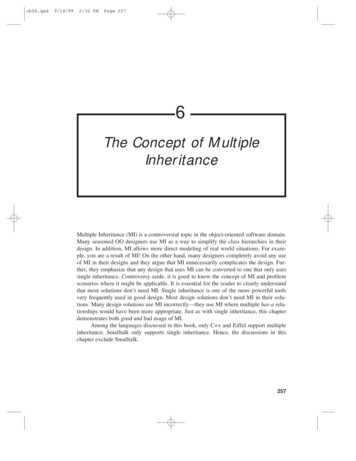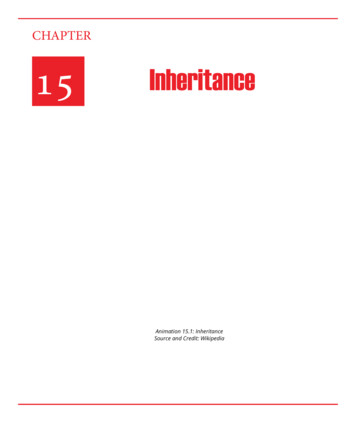
Transcription
CHAPTER15InheritanceAnimation 15.1: InheritanceSource and Credit: Wikipedia
15. InheritanceeLearn.PunjabFor much of human history , people were unaware of the scientificdetails of how babies got the characteristics of their parents.People had always thought that there was some hereditaryconnection between parents and children, but the mechanismswere not understood. Many answers to the questions about howoffspring get the characteristics from their parents came fromGregor Mendel’s work. In this chapter, we will go through Mendel’swork and other discoveries of inheritance.Animation 15.2: DNASource and Credit: Estrellamountain15.1 Introduction To GeneticsGenetics is the branch of biology in which we study inheritance. Inheritance means the transmissionof characteristics from parents to offspring. These characteristics are called the traits. For example:in man height, colour of the eyes, intelligence etc. are all inheritable traits.Parents pass characteristics to their young through gene transmission. Equal numbers ofchromosomes from each parent are combined during fertilization. The chromosomes carry theunits of inheritance called the genes.15.2 Chromosomes And GenesGenes consist of DNA. They contain specific instructions for protein synthesis. In order to knowthe nature and working of genes, we will have to study chromosomes in detail. The body cellshave a constant number of paired chromosomes. The two chromosomes of a pair are known ashomologous chromosomes. In human body cells, there are 23 pairs of homologous chromosomesfor a total of 46 chromosomes. We may recall that during meiosis, the two members of eachchromosome pair separate and each of them enters into one gamete.Chromosome is made of chromatin material (simply as chromatin). Chromatin is a complexmaterial, made of DNA and proteins (mainly histone proteins). DNA wraps around histone proteinsand forms round structures, called nucleosomes. DNA is also present between nucleosomes. Inthis way, the nucleosomes and the DNA between them look like “beads on a string” (Fig. 15.1).2
15. InheritanceeLearn.PunjabThe fibres consisting of nucleosomes condense into compact forms and get the structure ofchromosomes.Figure 15.1: Chemical composition of chromosomeWatson-Crick Model of DNAIn 1953, James Watson and Francis Crick proposed the structure for DNA.According to the Watson-Crick model, a DNA molecule consists of two polynucleotide strands.These strands are coiled around each other in the form of a double helix. There is a phosphatesugar backbone on the outside of double helix, and the nitrogenous bases are on the inside. Indouble helix, the nitrogenous bases of opposite nucleotides form pairs through hydrogen bonds.This pairing is very specific. The nitrogenous base adenine of one nucleotide forms pair with thethymine of opposing nucleotide, while cytosine forms pair with guanine. There are two hydrogenbonds between adenine and thymine while there are three hydrogen bonds between cytosineand guanine.DNA ReplicationWe have studied in Grade IX (cell cycle) that before a cell divides, its DNA is replicated (duplicated).It is done to make the copies of the chromatids of chromosomes. During replication, the DNAdouble helix is unwound and the two strands are separated, much like the two sides of a zipper.Each strand acts as a template to produce another strand. Its N- bases make pairs with the N-basesof new nucleotides. In this way, both template strands make new polynucleotide strands in frontof them. Each template and its new strand together then form a new DNA double helix, identicalto the original.3
15. InheritanceeLearn.PunjabHow Does the DNA ofChromosome work?DNA is the genetic material i.e. it containsthe instructions to direct all the functionsof cells. It performs its role by givinginstructions for the synthesis of specificproteins. Some proteins perform structuralroles while the others act as enzymes tocontrol all biochemical reactions of cells.In this way, whatever a cell does, is actuallycontrolled by its DNA. In other words,DNA makes the characteristic or trait ofcell or organism. Let us see how DNA isresponsible for this (Fig. 15.4).Figure 15.2: The Watson and Crick model of DNAFigure 15.3: How does DNA replicate?4
15. InheritanceeLearn.PunjabFigure 15.4: Working of DNA (also called the Central Dogma)We studied that traits are made by specific proteins. Specific proteins have specific number andsequence of their amino acids. DNA controlsthis sequence of amino acids by the sequenceof its nucleotides. During protein synthesis,the sequence of DNA nucleotides decidesthat what will be the sequence of aminoacids. For this purpose, the specific sequenceof DNA nucleotides is copied in the form ofmessenger RNA (mRNA) nucleotides. Thisprocess is called transcription. The mRNAcarries the sequence of its nucleotides toribosome. The ribosome reads this sequenceAnimation 15.3: DNA-Barcodingand joins specific amino acids, accordingSource and Credit: Dnalto it, to form protein. This step is knownas translation (Fig. 15.4).The part of DNA(sequence of nucleotides) that contains theinstructions for the synthesis of a particular protein is known as a gene. DNA of each chromosomecontains thousands of genes. Like chromosomes, genes also occur in pairs, one on each homologouschromosome. The locations or positions of genes on chromosomes are known as loci (Singular:locus).5
15. InheritanceeLearn.PunjabAnimation 15.4: DNA-ProteinSource and Credit: Employees.csbsjuAnimation 15.5: Promoter and TerminatorSource and Credit: Biology.kenyonEach gene determines a particular trait in an organism. Eachindividual carries at least one pair of genes for each trait. Forconvenience, pairs of genes are represented by a letter orsymbol. Both members of a gene pair may be the same insome individuals (a condition which we may represent as AAor aa or BB) and different in others (Aa or Bb). It means thata gene exists in more than one alternate forms. In the aboveexample, ‘A’ and ‘a’ are the two alternate forms of a geneand ‘B’ and ‘b’ are the alternate forms of another gene. Thealternate forms of a gene are called alleles. If an individualhas Aa gene pair, ‘A’ and ‘a’ are the alleles of one another.In this individual, allele ‘A’ is located on one of the twohomologous chromosomes and the allele ‘a’ is on the otherchromosome as shown in Figure 15.5. When chromosomesseparate during meiosis, alleles also separate and eachgamete gets one of the two alleles. When gametes of bothparents unite, the zygote (and the offspring also) receivesone allele from each parent.6Figure 15.5: Location of alleles onchromosomes
15. InheritanceeLearn.PunjabGenotype and its TypesThe specific combination of genes in an individual isknown as genotype. It is of two types i.e. homozygousand heterozygous. In order to understand the conceptof genotype, let us consider an example trait i.e.albinism (a condition in which normal body pigmentsare absent). Like other traits, it is also controlled by onepair of genes. We can represent the two alleles of thepair as ‘A’ and ‘a’. Three combinations i.e. genotypesare possible for these two alleles i.e. AA, Aa, and aa.These genotypes can be grouped into two types. Thegenotype in which the gene pair contains two identicalalleles (AA or aa), is called homozygous genotype. Thegenotype in which the gene pair contains two differentAnimation 15.6: ChromosomesSource and Credit: Tokyo-medalleles (Aa), is called heterozygous genotype.When in the heterozygous condition one allele masksor prevents the expression of the other, it is called the dominant allele. The allele which is notexpressed is called recessive.The dominant alleles are represented by capital letters and recessive alleles by lower case letters.Albinism is a recessive trait i.e. it is produced when both alleles are recessive. In humans, allele ‘A’produces normal body pigments while allele ‘a’ does not produce pigments. If genotype is AA orAa, the individual will produce pigments. On the other hand, if genotype is aa, no pigments will beproduced and the individual will be albino. In this example, you see that the allele ‘A’ dominatesover ‘a’, because in Aa indiviual pigments are produced and the effect of ‘a’ is suppressed by ‘A’.The expression of this genotype in the form of trait (in our example, being albino or having normalpigmentation) is known as the phenotype.A dominant allele only suppresses the expression of recessive allele. It does not affect its nature.7
15. InheritanceeLearn.Punjab15.3 Mendel’s Laws Of InheritanceGregor Mendel was a monk (priest) in Austria. He developed the fundamental principles of genetics.Mendel proposed that there are “special factors” inorganisms, which control the expression of traits andtheir transmission to next generations. These factorswere eventually termed genes.Mendel selected pea plant (Pisum sativum) to carryout a large number of experiments. In his writings,he gave reasons for this selection. He argued that anorganism for genetic experiments should have thefollowing features:Mendel used 28,000 pea plants in his experiments. There should be a number of different traits thatSource & Credit: Wikipediacan be studied (Fig. 15.6). The organism should have contrasting traits e.g. forthe trait of height there should be only two very different phenotypes i.e. tallness and dwarfness. The organism (if it is a plant) should be self-fertilizing but cross fertilization should also bepossible. The organism should have a short but fast life cycle.All these features are present in pea plant. Normally, the flowers of pea plant allow self-pollination.Cross pollination can also be done by transferring the pollen grains from the flower on one plantto the flower on another plant. Each trait studied in pea plant had two distinct forms. Mendelsucceeded in his work not only because he selected the right organisms for his experiments butalso because he analyzed the results by using the principles of statistics (ratios).15.3.1 Mendel’s Law of SegregationMendel studied the inheritance of seed shape first. For this purpose, he crossed (reproduced) twoplants having one contrasting trait i.e. seed shape. A cross in which only one trait is studied at atime, is called as a monohybrid cross. Mendel crossed a true-breeding round-seeded plant with atrue-breeding wrinkled-seeded plant.8
15. InheritanceeLearn.PunjabFigure 15.6: Traits in Pea Plant studied by MendelAll resulting seeds of the next generation were round. Mendel declared the trait “round seeds” asdominant, while “wrinkled seeds” as recessive. The following year, Mendel planted these seedsand allowed the new plants to self-fertilize. As a result, he got 7324 seeds: 5474 round and 1850wrinkled (3 round : 1wrinkled). The parental generation is denoted as P1 generation. The offspringof P1 generation are F1 generation (first filial). The cross in F1 generation produces F2 generation(second filial).9
15. InheritanceeLearn.PunjabSimilarly, when “true-breeding” tall plants were crossed with “true-breeding” short plants, alloffspring of F1 were tall plants i.e. tallness was a dominant trait. When members of F1 generationwere self-fertilized, Mendel got the ratio of tall to short plants in F2 as 3:1.Mendel concluded that the traits under study were controlled by discrete (separable) factors orgenes. In each organism, the genes are present in pairs. During gamete formation, the genes(alleles) of each pair segregate from each other and each gamete receives one gene from the pair.When the gametes of male and female parents unite, the resulting offspring agains gets the genesin pairs. These conclusions were called the Law of Segregation.15.3.2 Mendel’s Law of Independent AssortmentIn the next crosses, Mendel studied two contrasting traits at a time. Such crosses are calleddihybrid crosses. He performed experiments on two seed traits i.e. shape and colour. The traitof round seeds (controlled by allele R) was dominant over wrinkled (controlled by allele r) seeds.Similarly, yellow seed colour (controlled by Y) was dominant over green (controlled by y). Mendelcrossed a truebreeding plant that had round yellow seeds (RRYY) with a truebreeding plant havingwrinkled green seeds (rryy). All seeds in F1 generation were round yellow.10
15. InheritanceeLearn.PunjabWhen F1 seeds grew into plants, they were self-fertilized. This cross produced seeds with fourphenotypes. There were 315 round yellow seeds, 108 round green seeds, 101 wrinkled yellowseeds and 32 wrinkled green seeds. The ratio of these phenotypes was 9:3:3:1.11
15. InheritanceeLearn.PunjabThe Punnett square is a diagram that is used to predict an outcome of a particular cross orbreeding experiment. It is named after R. C. Punnett (an English mathematician). The gametes ofboth parents having all possible genetic set-ups are determined. A checker board is used to crossall the possible gametes of one parent with all the gametes of other parent. In this way, a biologistcan find all the possible genotypes of offsprings.Mendel explained that the two traits i.e. seed shape and seed colour are not tied with each other.The segregation of ‘R’ and ‘r’ alleles happens independently of the segregation of ‘Y’ and ‘y’ alleles.From his second experiment, Mendel concluded that different traits are inherited independentlyof one another. This principle is known as the law of independent assortment. It states as: “thealleles of a gene pair segregate (get separated and distributed to gametes) independently from thealleles of other gene pairs”.15.4 Co-Dominance And Incomplete DominanceAfter the discovery of Mendel’s work, scientists began experiments on the genetics of variousorganisms. These experiments proved that all the traits in organisms do not follow Mendel’s laws.For example, it was found that there are many traits which are controlled by more than one pair ofgenes. Similarly for many traits, there are more than two alleles in a gene pair. Co-dominance andincomplete dominance are two examples of such deviations from Mendel’s laws.12
15. InheritanceeLearn.PunjabCo-dominance is the situation where two different alleles of a gene pair express themselvescompletely, instead of showing a dominant-recessive relationship. As a result, the heterozygousorganism shows a phenotype that is different from both homozygous parents.An example of co-dominance is the expression of human blood group AB. The ABO blood groupsystem is controlled by the gene ‘I’. This gene has three alleles i.e. IA, IB and i. The allele IA producesantigen A in blood and the phenotype is blood group A. The allele IB produces antigen B in bloodand the phenotype is blood group B. The allele i does not produce any antigen and the phenotypeis blood group O. The alleles IA and IB are dominant over i. When there is a heterozygous genotypeof IA IB, each of the two alleles produces the respective antigen and neither of them dominates overthe other.AntigenproducedPhenotypeRelationshipBetween AllelesAntigen ABlood Group AAllele IA is dominant over iAntigen BBlood Group BAllele IB is dominant over iiiNo AntigenBlood Group OAllele i is recessiveIAIBAntigen A &Antigen BBlood Group ABAlleles IA and IB are co-dominantGenotypeIAIAorIAiIBIBorIBiIn-complete dominance is the situation where, in heterozygous genotypes, both the alleles expressas a blend (mixture) and neither allele is dominant over the other. As a result of this blending, anintermediate phenotype is expressed. Following is the familiar example of incomplete dominance.13
15. InheritanceeLearn.PunjabIn Four ‘O’ Clock plants, the 3 flower colours are red, pink and white. There is no specific generesponsible for producing pink flowers.In Four ‘O’ clock plant, the trait of flower colour is controlled by two alleles (let us say them R and r).The true breeding plants RR and rr have red and white flowers, respectively. When a homozygousred flowered plant (RR) is crossed with homozygous white flowered plant (rr), the heterozygous (Rr)plants of F1 generation produce pink flowers (pink is a blend of red and white colours). This resultclearly indicates that neither of the red flower allele (R) and white flower allele (r) is dominant.However, when two heterozygous plants with pink flowers (Rr) are crossed, F2 generation showsphenotypes of red, pink and white flowers in the ratio 1:2:1.Initiating and Planning: Predict from pedigree charts the passage of traits from one generation to the other. Solve basic genetic problems involving monohybrid crosses, incomplete dominance and codominance, using the Punnet square.14
15. InheritanceeLearn.Punjab15.5 Variations And EvolutionIn the previous chapter, we studied that sexual reproduction produces variations in the nextgeneration. No two individuals resulting from separate fertilizations are genetically identical. Themain sources of variations in sexually reproducing populations are describes next. The genetic recombination produced through crossing over (recall from previous studies thatcrossing over occurs during meiosis) results in gametes with variations. Mutations (changes in DNA) are important source of variations. Mutations also happen duringgametes formation through meiosis. During fertilization, one of the millions of sperms combines with a single egg. The chanceinvolved in this combination also act as the source of variations. Gene flow i.e. movement of genes from one population to another is also an important sourceof variations.Practical: Record the heights of class fellow’s to predict which kind of variation is it. Present the data of class fellow’s heights in graphical form.Discontinuous and Continuous VariationsThe inheritable variations are of two types i.e. discontinuous and continuous variations.Discontinuous variations show distinct phenotypes. The phenotypes of such variations cannot bemeasured. The individuals of a population either have distinct phenotypes, which can be easilydistinguished from each other. Blood groups are a good example of such variations. In a humanpopulation, an individual has one of the four distinct phenotypes (blood groups) and cannothave in between. Discontinuous variations are controlled by the alleles of a single gene pair. Theenvironment has little effect on this type of variations. In continuous variations, the phenotypesshow a complete range of measurements from one extreme to the other. Height, weight, feetsize, intelligence etc. are example of continuous variations. In every human population, theindividuals have a range of heights (from very small to tall). No population can show only two orthree distinct heights. Continuous variations are controlled by many genes and are often affectedby environmental factors.15
15. InheritanceeLearn.Punjab15.5.1 Variations lead to EvolutionOrganic evolution (biological evolution) is the change in thecharacteristics of a population or species of organisms over thecourse of generations. The evolutionary changes are alwaysinheritable. The changes in an individual are not considered asevolution, because evolution refers to populations and not toindividuals. Organic evolution includes two major processes: Alteration in genetic characteristics (traits) of a type of organismover time; and Creation of new types of organisms from a single type.Animation15.8: Darwin-EvolutionSource and Credit: Zebu.uoregon9The study of evolution determines the ancestry and relationships among different kinds oforganisms. The anti-evolution ideas support that all living things had been created in their currentform only a few thousand years ago. It is known as the “theory of special creation”. But thescientific work in eighteenth century led to the idea that living things might change as well.Variations are also caused by different combinations of chromosomes in gametes and thenin zygote. In the case of humans, the possible number of chromosomal combinations atfertilization is 70,368,744,177,664. In other words, a couple can produce more than 70 trilliongenetically different children!16
15. InheritanceeLearn.PunjabFrench biologist C. de Buffon(1707–1788) was the first to hint at evolution. His countryman J. de Lamarck (1744–1829) wasthe first to propose a mechanism of evolution. Lamarck’s ideas were soon rejected due to thevagueness of the mechanisms he proposed.17
15. InheritanceeLearn.PunjabCharles Darwin (1809–1882) proposed the mechanism of organic evolution in 1838. It was calledas “The Theory of Natural Selection”. Darwin proposed this theory after his 5-year voyage on theHMS (His Majesty’s Ship) Beagle. He also published a book “On the Origin of Species by means ofNatural Selection” in 1859. Darwin’s theory of evolution was not widely accepted because of lackof sufficient evidence. Modern evolutionary theory began in the late 1920s and early 1930s. Somescientists proved that the theory of natural selection and Mendelian genetics are the same ideasjust as Darwin had proposed.C. de BuffonJ. de LamarckMechanism of Evolution - Natural SelectionAlmost every population contains several variations for the characteristics of its members. In otherwords, there are morphological and physiological variations in all populations. Natural selection isthe process by which the better genetic variations become more common in successive generationsof a population.The central concept of natural selection is the evolutionary fitness of an organism. Fitness meansan organism’s ability to survive and reproduce. Organisms produce more offspring than cansurvive and these offspring vary in fitness. These conditions produce struggle for survival amongthe organisms of population . The organisms with favourable variations are able to reproduce andpass these variations to their next generations.18
15. InheritanceeLearn.PunjabOn the other hand, the rate of the transmission of unfavourable to next generations is low. We cansay that the favourable variations are “selected for” their transmission to next generations, whilethe unfavourable variations are “selected against” their transmission to next generations. In theexample mentioned next, we can see a mouse population with variations in skin colour. Cat preysupon light and medium coloured mouse. In first generation, light coloured mouse is preyed uponby cat.Figure 15.7: The concept of natural selection19
15. InheritanceeLearn.PunjabDifferent populations face different environments and they have to adapt to different conditions.Only medium and dark coloured mouse can make their next generations. In next generation,population again contains light, medium and dark coloured mouse. Cat preys upon the lightand medium coloured mouse. Now only the dark coloured mouse make new generation. If thishappens in many generations, we will see only the dark coloured (favourable variation) mouse inthe population (Fig. 15.7).As a result of natural selection, the allele that gives more fitness of characteristics (favourablevariations) than other alleles becomes more common within population. So, the individuals withfavourable variations become a major part of population while the individuals with harmful orunfavourable variations become rarer.In England, the moths had two variations i.e. dark and white coloured moths (Fig.15.8). The mothsused to rest on the light coloured tree trunks (on which white lichens had grown). In the 19th centurywhen industries were established in England, the lichens on tree trunks died (due to polluted air)and the naked tree trunks turned dark. Now the white moth variation became harmful becausea white moth resting on a dark tree trunk was easily visible to the predatory birds. The naturalselection selected dark moths to reproduce. In this way dark coloured moth became more commonand at last the white moths disappeared from population. In this case, the dark colour variation inmoth may be considered an adaptation to environment.20
15. InheritanceeLearn.PunjabFigure 15.8: White and dark coloured mothsInitiating and Planning:Write down the procedure of an experiment in which you can cross true-breeding tall and shortplants to get tall plants and can test the natural selection of these variants.21
15. InheritanceeLearn.Punjab15.5.2 Artificial SelectionThe term “artificial selection” was expressed by the Persian scientist Abu Rayhan Biruni in the 11thcentury. Charles Darwin also used this term in his work on natural selection. He noted that manydomesticated animals and plants had special properties that were developed by: Intentional breeding among individuals with desirable characteristics; and Discouraging the breeding of individuals with less desirable characteristicsArtificial selection (or selective breeding) means intentional breeding between individuals for certaintraits, or combination of traits. Selective breeding has revolutionized agricultural and livestockproduction throughout the world. Animals or plants having desirable characteristics are selectedfor breeding. In this way, many new generations with desirable characteristics are produced. Inartificial selection, the bred animals are known as breeds, while bred plants are known as varietiesor cultivars. Numerous breeds of sheep, goat, cow, hen etc. have been produced by artificialselection to increase the production of wool, meat, milk, eggs etc.Similarly many plant varieties (cultivars) have been produced for better quantity and quality ofcereals, fruits and vegetables.Figure 15.9: Breeds of hen, produced through artificial selectionIn artificial selection, humans favour specific variations for selection while in natural selectionthe environment selects or rejects variations.22
15. InheritanceeLearn.PunjabInitiating and Planning: Analyze a case study of variation and selection e.g. in peppered moth. Analyze how artificial selection can lead to the development of crop plants with higher yields.Animation 15.9: EvolutionSource and Credit: Ewh.ieee23
15. InheritanceeLearn.PunjabFigure 15.10: Plant varieties produced through artificial selection in wild mustardUNDERSTANDING THE CONCEPT1.2.3.4.5.6.Describe the structure of chromatin.Describe Mendel’s law of segregation.Explain how Mendel proved the law of independent assortment.How would you prove that variations lead to evolution?Explain the phenomenon of incomplete dominance with the help of example.What do you mean by co-dominance. Give an example.SHORT QUESTIONS1.2.3.4.Define genotype and phenotype.What do you mean by dominant and recessive alleles?What are the homozygous and heterozygous genotypes?Differentiate between natural and artificial selection.24
15. InheritanceeLearn.PunjabACTIVITIES1. Draw the chromosomes of a plant cell after observing in prepared slides unlabelled charts.2. Record the heights of class fellows to predict which kind of variation is it.3. Present the data of class fellows’ heights in graphical form.THE TERMS TO KNOWAlleleArtificial id gouschromosomesHomozygousIncomplete dominanceInheritanceLocusMonohybrid crossMutationNatural selectionNucleosomeOrganic evolutionPhenotypeRecessive traitTraitTrue-breedingVariationsSCIENCE, TECHNOLOGY AND SOCIETY1. Describe various possibilities if humans could be able to control the functioning of genes.2. Prepare a report using newspaper clippings on the recent advances and future possibilities ingenetics.3. Rationalize life as a product of the diversity brought about by chromosomes, genes and DNA.4. Outline the scientific findings and some of the technological advances that led to the modernconcept of gene.5. Analyse the concept of gene to produce various proteins of the body.6. Describe the importance of scientific investigation and mathematical know how in genetics.7. Explain how genetics can predict the progeny of two individuals which are crossed.8. What is the role of environment on the selection of better variations?ON-LINE LEARNING1. en.wikipedia.org/wiki/Punnett square2. www.uic.edu/classes/bios/bios101/genes13. www.human-nature.com/darwin/4. en.mimi.hu › Biology25
15.3.1 Mendel's Law of Segregation Mendel studied the inheritance of seed shape first. For this purpose, he crossed (reproduced) two plants having one contrasting trait i.e. seed shape. A cross in which only one trait is studied at a time, is called as a monohybrid cross. Mendel crossed a true-breeding round-seeded plant with a

